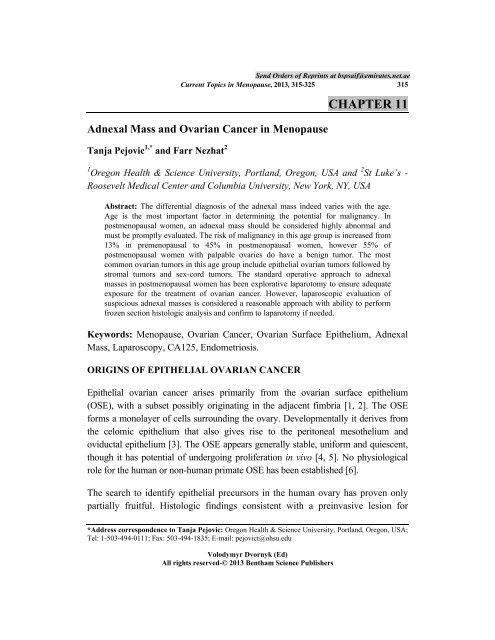Download - Bentham Science
Download - Bentham Science
Download - Bentham Science
Create successful ePaper yourself
Turn your PDF publications into a flip-book with our unique Google optimized e-Paper software.
Send Orders of Reprints at bspsaif@emirates.net.ae<br />
Current Topics in Menopause, 2013, 315-325 315<br />
Adnexal Mass and Ovarian Cancer in Menopause<br />
Tanja Pejovic 1,* and Farr Nezhat 2<br />
CHAPTER 11<br />
1 Oregon Health & <strong>Science</strong> University, Portland, Oregon, USA and 2 St Luke’s -<br />
Roosevelt Medical Center and Columbia University, New York, NY, USA<br />
Abstract: The differential diagnosis of the adnexal mass indeed varies with the age.<br />
Age is the most important factor in determining the potential for malignancy. In<br />
postmenopausal women, an adnexal mass should be considered highly abnormal and<br />
must be promptly evaluated. The risk of malignancy in this age group is increased from<br />
13% in premenopausal to 45% in postmenopausal women, however 55% of<br />
postmenopausal women with palpable ovaries do have a benign tumor. The most<br />
common ovarian tumors in this age group include epithelial ovarian tumors followed by<br />
stromal tumors and sex-cord tumors. The standard operative approach to adnexal<br />
masses in postmenopausal women has been explorative laparotomy to ensure adequate<br />
exposure for the treatment of ovarian cancer. However, laparoscopic evaluation of<br />
suspicious adnexal masses is considered a reasonable approach with ability to perform<br />
frozen section histologic analysis and confirm to laparotomy if needed.<br />
Keywords: Menopause, Ovarian Cancer, Ovarian Surface Epithelium, Adnexal<br />
Mass, Laparoscopy, CA125, Endometriosis.<br />
ORIGINS OF EPITHELIAL OVARIAN CANCER<br />
Epithelial ovarian cancer arises primarily from the ovarian surface epithelium<br />
(OSE), with a subset possibly originating in the adjacent fimbria [1, 2]. The OSE<br />
forms a monolayer of cells surrounding the ovary. Developmentally it derives from<br />
the celomic epithelium that also gives rise to the peritoneal mesothelium and<br />
oviductal epithelium [3]. The OSE appears generally stable, uniform and quiescent,<br />
though it has potential of undergoing proliferation in vivo [4, 5]. No physiological<br />
role for the human or non-human primate OSE has been established [6].<br />
The search to identify epithelial precursors in the human ovary has proven only<br />
partially fruitful. Histologic findings consistent with a preinvasive lesion for<br />
*Address correspondence to Tanja Pejovic: Oregon Health & <strong>Science</strong> University, Portland, Oregon, USA;<br />
Tel: 1-503-494-0111; Fax: 503-494-1835; E-mail: pejovict@ohsu.edu<br />
Volodymyr Dvornyk (Ed)<br />
All rights reserved-© 2013 <strong>Bentham</strong> <strong>Science</strong> Publishers
















